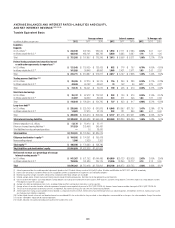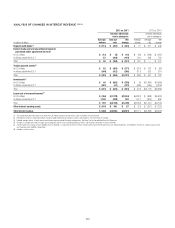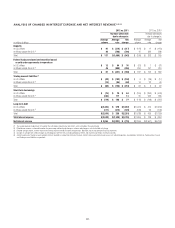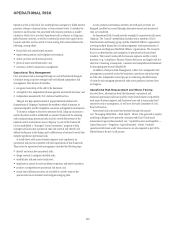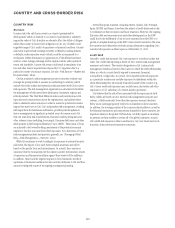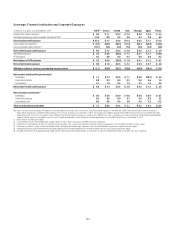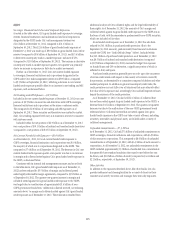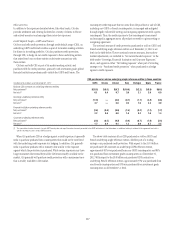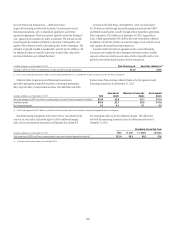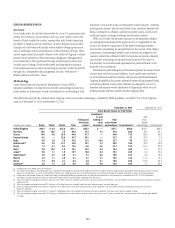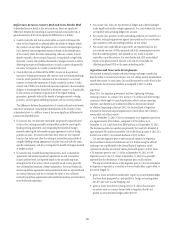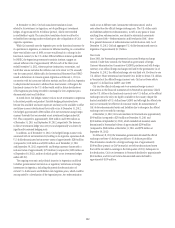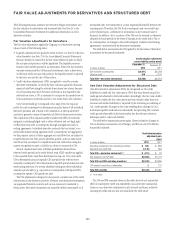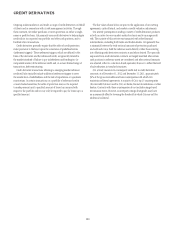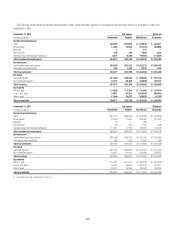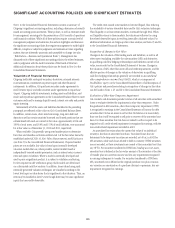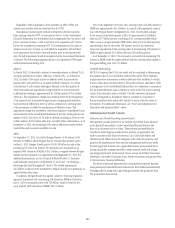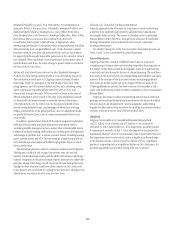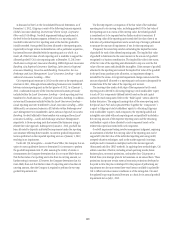Citibank 2012 Annual Report Download - page 141
Download and view the complete annual report
Please find page 141 of the 2012 Citibank annual report below. You can navigate through the pages in the report by either clicking on the pages listed below, or by using the keyword search tool below to find specific information within the annual report.119
Redenomination and Devaluation Risk
As referenced above, the ongoing Eurozone debt crisis and other
developments in the European Monetary Union (EMU) could lead to the
withdrawal of one or more countries from the EMU or a partial or complete
break-up of the EMU. See also “Risk Factors—Market and Economic Risks.”
If one or more countries were to leave the EMU, certain obligations relating
to the exiting country could be redenominated from the Euro to a new
country currency. While alternative scenarios could develop, redenomination
could be accompanied by immediate devaluation of the new currency as
compared to the Euro and the U.S. dollar.
Citi, like other financial institutions with substantial operations in
the EMU, is exposed to potential redenomination and devaluation risks
arising from (i) Euro-denominated assets and/or liabilities located or held
within the exiting country that are governed by local country law (“local
exposures”), as well as (ii) other Euro-denominated assets and liabilities,
such as loans, securitized products or derivatives, between entities outside of
the exiting country and a client within the country that are governed by local
country law (“offshore exposures”). However, the actual assets and liabilities
that could be subject to redenomination and devaluation risk are subject to
substantial legal and other uncertainty.
Citi has been, and will continue to be, engaged in contingency planning
for such events, particularly with respect to Greece, Ireland, Italy, Portugal
and Spain. Generally, to the extent that Citi’s local and offshore assets
are approximately equal to its liabilities within the exiting country, and
assuming both assets and liabilities are symmetrically redenominated and
devalued, Citi believes that its risk of loss as a result of a redenomination
and devaluation event would not be material. However, to the extent its local
and offshore assets and liabilities are not equal, or there is asymmetrical
redenomination of assets versus liabilities, Citi could be exposed to losses
in the event of a redenomination and devaluation. Moreover, a number of
events that could accompany a redenomination and devaluation, including
a drawdown of unfunded commitments or “deposit flight,” could exacerbate
any mismatch of assets and liabilities within the exiting country.
Citi’s redenomination and devaluation exposures to the GIIPS as of
December 31, 2012 are not additive to its credit risk exposures to such
countries as described under “Credit Risk” above. Rather, Citi’s credit risk
exposures in the affected country would generally be reduced to the extent of
any redenomination and devaluation of assets.
As of December 31, 2012, Citi estimates that it had net asset exposure
subject to redenomination and devaluation in Italy, principally relating to
derivatives contracts. Citi also estimates that, as of such date, it had net asset
exposure subject to redenomination and devaluation in Spain, principally
related to offshore exposures related to held-to-maturity securitized retail
assets (primarily mortgage-backed securities) and exposures to Private Bank
customers (see “GIIPS—Retail, Small Business and Citi Private Bank”
above). However, as of December 31, 2012, Citi’s estimated redenomination
and devaluation exposure to Italy was less than Citi’s net current funded
credit exposure to Italy (before purchased credit protection) as reflected
under “Credit Risk” above. Further, as of December 31, 2012, Citi’s estimated
redenomination and devaluation exposure to Spain was less than Citi’s net
current funded credit exposure to Spain (before purchased credit protection),
as reflected under “Credit Risk” above. As of December 31, 2012, Citi had a
net liability position in each of Greece, Ireland and Portugal.
As referenced above, Citi’s estimated redenomination and devaluation
exposure does not include purchased credit protection. As described under
“Credit Risk” above, Citi has purchased credit protection primarily from
investment grade, global financial institutions predominantly outside of
the GIIPS. To the extent the purchased credit protection is available in
a redenomination/devaluation event, any redenomination/devaluation
exposure could be reduced.
Any estimates of redenomination/devaluation exposure are subject to
ongoing review and necessarily involve numerous assumptions, including
which assets and liabilities would be subject to redenomination in any given
case, the availability of purchased credit protection and the extent of any
utilization of unfunded commitments, each as referenced above. In addition,
other events outside of Citi’s control— such as the extent of any deposit
flight and devaluation, the imposition of exchange and/or capital controls,
the requirement by U.S. regulators of mandatory loan loss and other reserve
requirements or any required timing of functional currency changes and
the accounting impact thereof —could further negatively impact Citi in
such an event. Accordingly, in an actual redenomination and devaluation
scenario, Citi’s exposures could vary considerably based on the specific facts
and circumstances.


